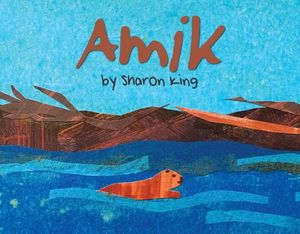Sharon King on How Her Beautiful New Picture Book Can Support Learners of the Ojibwe Language
Sharon King's Amik (Kegedonce Press) is a gentle and welcoming journey into the natural world. Amik means beaver in the Ojibwe language, and each page features Anishinaabemowin and English words to tell the story of Amik's diligent work building his dam, his cozy time spent with his family, and the experiences of the other animals in his environment.
King, who was nominated for Juno as part of the Aboriginal Women's Voices Group and works as an educator in the Wasauksing First Nation, has created a serene and winning story, with her quietly stunning cut-paper artwork shining throughout. The intricate collages are deceptively simple, with the complex and patient layering King uses to achieve such a beautiful effect apparent on closer inspection.
The bilingual aspect of the book, where the English translation follows the Anishinaabemowin writing, is a fantastic opportunity for young readers to engage with colourful and thoughtful nature story in a new way. We're excited to welcome Sharon to Open Book today to talk about Amik.
She tells us about how she hopes Amik can be a resource for those learning the Ojibwe language regardless of age, which animal in Amik's world she relates to the most, and how long walks feature in her artistic and writing process.
Open Book:
Tell us about your new book and how it came to be.
Sharon King:
The book originally became an idea from an assignment while I was studying early childhood education. From that point on I created the idea of an interpretation of how one might view the environment as just being an observer.
OB:
Is there a message you hope kids might take away from reading your book?
SK:
First and foremost, the most important thing about the book is that it is originally written for children to understand Ojibwe language. I’d like to also add it provides a good learning experience for adults who are just understanding and or learning their Ojibwe language. Secondly the book is understood from a perspective how we engage with our outdoor environment.
OB:
Did the book look the same in the end as your originally envisioned it when you started working, or did it change through the writing process?
SK:
The book actually started with a storyboard and with each card I just created different scenarios where the beaver would come across differently. Each animal and being it came across, they just coexisted. So I guess the book really wrote itself, starting with waking up to the moon going down and then going to bed at night with the sun going down.
Your CanLit News
Subscribe to Open Book’s newsletter to get local book events, literary content, writing tips, and more in your inbox
OB:
Is there a character in your book that you relate to? If so, in what ways are you similar to your character and in what ways are you different?
SK:
I like the bear; I relate to the bear the most, mainly because he appears so chill and just going about his business. Having said that all the characters definitely are going about their business and are busy also.
OB:
What was the strangest or most memorable moment or experience during the writing process for you?
SK:
The most memorable part of writing the book was doing the illustrations and using the different materials to provide each page with different textures and colours with each animal and living thing together. That probably was the most memorable part of writing the book. The strangest part was bringing it all together and having to do the interpretations in the Ojibwe language.
OB:
What do you need in order to write – in terms of space, food, rituals, writing instruments?
SK:
The best time for me to write or create anything for that matter is usually late at night. Ideas somehow come and that creative flow comes in around one in the morning and lasts at least until four or five. Everyone is sleeping it’s quiet, it’s dark out, there are no interruptions and there’s a lot of time for me to think and work.
OB:
How do you cope with setbacks or tough points during the writing process? Do you have any strategies that are your go-to responses to difficult points in the process?
SK:
If I do have tough points or setbacks when I’m still trying to think of a premise for a story I like to take super long walks. This helps with clearing my head and opening my energy up to new ideas.
OB:
Do you feel like there are any misconceptions about writing for young people? What do you wish people knew about what you do?
SK:
It’s not as easy as it seems. To come up with a concept and idea. Have illustrations, have translators, complete artwork, and so on.
OB:
What's your favourite part of the life cycle of a book? The inspiration, writing the first draft, revision, the editorial relationship, promotion and discussing the book, or something else altogether? What's the toughest part?
SK:
My favourite part of writing a book is definitely the first draft. This is when all the ideas come in to play and illustration after illustration occur during this time and there’s so much room for creativity. The toughest part was deciding what gets cut and what stays in.
OB:
What are you working on now?
SK:
I am working on another book. The story is there visually. And now it’s just being put on paper.
_________________________________________
Sharon King is an educator, performer and producer. She is Potawatomi from the Wasauksing First Nation near Parry Sound. Most recently Sharon has worked at a community level as an educator in Wasauksing. She is best known for her Juno nomination in 1999 (Aboriginal Women's Voices, Hearts of the the Nation). She has produced community arts programs and her travels have helped with a strong connection to artists, filmmakers, and producers in Canada. Her strong hold on Indigenous culture and singing has maintained her efforts in her keeping tradition present with her family and community.






